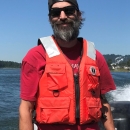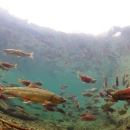The fishway at Warm Springs National Fish Hatchery was designed and constructed in the mid-1970’s before modern fish passage fish passage
Fish passage is the ability of fish or other aquatic species to move freely throughout their life to find food, reproduce, and complete their natural migration cycles. Millions of barriers to fish passage across the country are fragmenting habitat and leading to species declines. The U.S. Fish and Wildlife Service's National Fish Passage Program is working to reconnect watersheds to benefit both wildlife and people.
Learn more about fish passage standards were established, including those for Pacific lamprey. Consequently, our fishway evaluation at the hatchery demonstrates significant passage deficiencies for Pacific lamprey, likely delaying and limiting passage through the fishway. Passage limitations for bull trout through the fishway were not as significant. Additional biological assessments including telemetry and video monitoring could quantify the most significant issues in the fishway and subsequent modification of fish physical structures could improve passage conditions. The most significant passage issues observed for Pacific lamprey in the hatchery were: probable delay and entrainment issues at turning pool B1, high water velocities through the vertical slot weirs, a passage-limiting design at the vertical slot weir leading into the transport channels, lack of adequate attachment substrate at the fishway entrance, a passage limiting design of the fishway exit, and a lack of rounded edges and corners throughout the fishway. For Pacific lamprey, an alternative solution would be a Lamprey Alternative Passage System or (LAPS) that could be installed to circumvent all of the passage concerns in the fishway. Considering the dramatic declines in Pacific lamprey numbers and the time and resources required to conduct the fishway assessments, a LAPS may be a more cost effective and efficient fish passage alternative.
Darren Gallion
Publication date
Type of document
Report
Facility
Program
Species
FWS Focus
FWS Focus
FWS and DOI Region(s)





